There is literally no end to the number of items that can be mounted on an AR-15 rifle in some fashion, whether it’s a high-end $4,000 scope designed for extreme range shooting or a rail-mounted bottle opener for extreme range drinking. Of all the things that you’re able to stick on an AR, though, the most common and seemingly least understood are iron sights.
Most people have a basic working knowledge of what iron sights are supposed to do, but often not much understanding of what makes them work or what they’re really good for. I hear it said over and over again these days that red dot sights and scopes are in all ways superior to iron sights, which, for many shooters, are nothing but close-range afterthoughts. But this is far from the truth.
The first myth we need to dispel is that AR-15 iron sights are cheap and outdated. The folks who think that are usually the same people who buy a budget set of low profile Picatinny-mounted iron sights that folds down, think of them strictly as backups, and only zero them by making them line up with their red dot in order to co-witness.
If you’re thinking that iron sights are the gun equivalent of that near-useless donut tire in your trunk, you’re doing it wrong. Don’t buy a cheap set of folding flip-up sights and expect them to perform with any degree of repeatability or precision. You can sometimes get away with just a rear sight if your gun already has a front sight integral to the barrel.
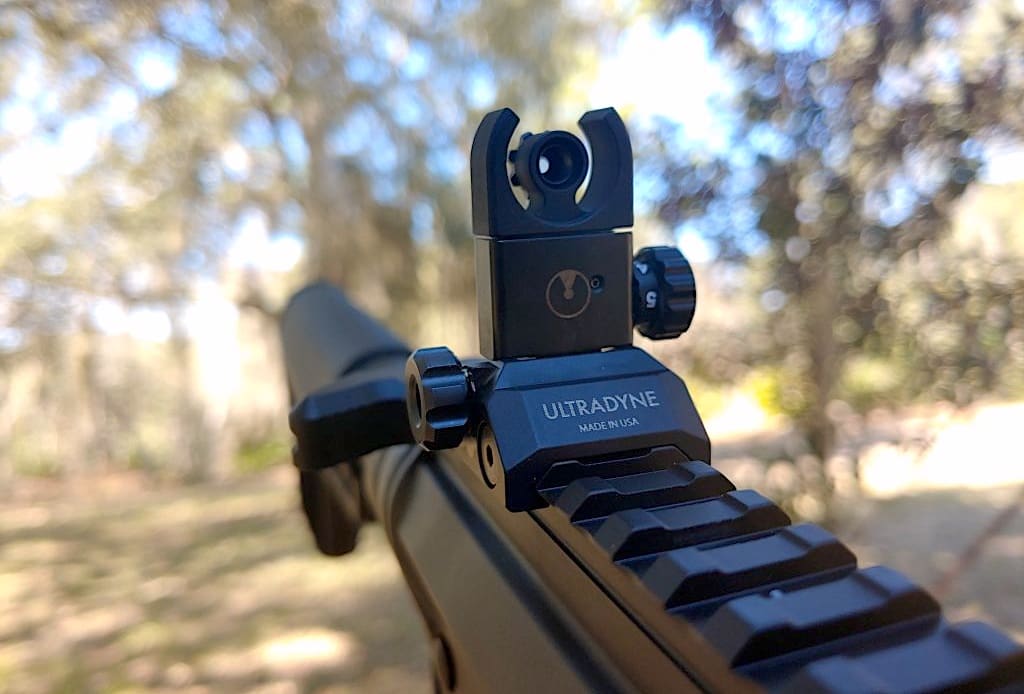
The “battle sights” I’m referencing here are usually found on the budget/junk tables at gun shows, right next to those $50 ‘tactical’ scopes and ‘military’ grade lasers. If you’re paying only $25 for a set of irons, you aren’t spending enough and you’re getting even less.
I don’t want to be a snob about it, but I guess I kinda am. I consider iron sight sets that are in the $125-300 range to be of the best quality. You can even get good set of BUIS with a 45 degree offset in this price range to use in tandem with a magnified optic.
I talked to a guy at the range when I was working on another article who had a $2,500 AR. His nice rifle was sporting a set of knockoff Magpul MBUS flip-ups mounted ‘just in case the SHTF’. It was obvious to me that he lacked the experience to prioritize some of the most important aspects of his gear.
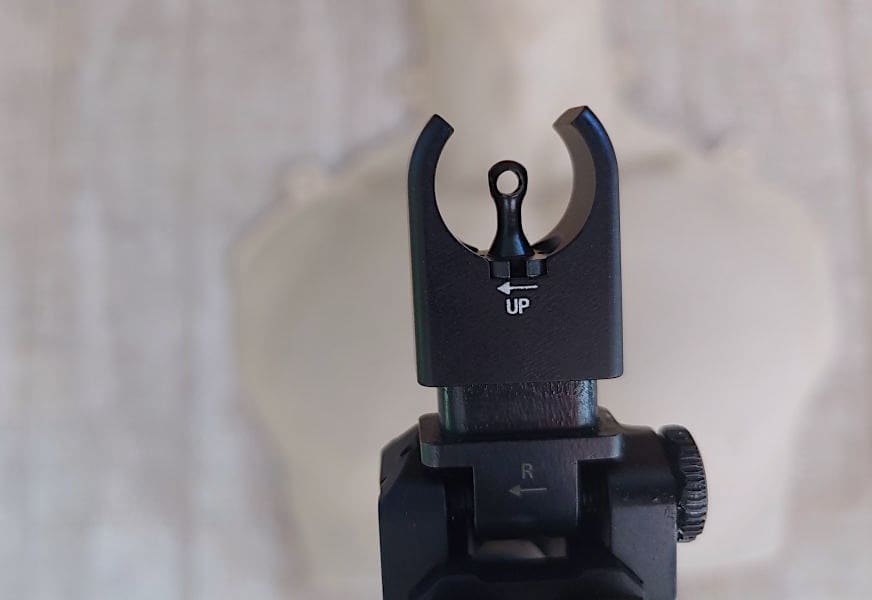
Most $1,500 rifles are easily as good has the one he bought, and with the $1000 he’d have saved, he could have afforded a better, well, everything else he had attached to it. A great rifle is nothing special when you’re aiming it with junk.
A high quality set of AR-15 iron sights will give you greater precision than any red dot and many magnified scopes. If you have cash for a cheap scope in the $200 range, realize that the USA-made, world-class set of sights pictured in this article, the Scalarworks PEAK sights, are $130 for the set. You can either buy cheap, easily-broken gun show junk, or you can buy something that works and will last. Your choice.
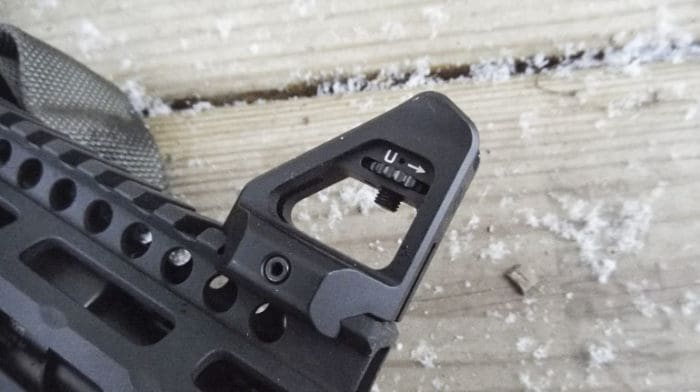
This brings us to the next problem associated with AR-15 iron sights: zeroing. There are many philosophies surrounding this and lots of ways to zero a rifle. Some can be hard to grasp, especially for newer shooters.
I’m a National Match competitor and have won all my CMP medals with iron sights, but they are never zeroed at point of aim. How is that possible?
Well, I zero for what is called a six-o-clock hold, which means that my front post is aimed at the bottom of the black target center. My bullets impact about 7” high at 200 yards, which puts them in the center of the black.
The actual point the bullet intersects the tip of my front sight is somewhere around 275 yards depending on the caliber/bullet used. That means I can hold just a touch high to hit deer-sized game out to 325 yards, but would need to hold a bit low at 100 yards to be sure to hit the vitals, as I’d be hitting too high at that closer distance.
Having a ‘floating’ zero may seem like a foreign concept, but you’d be surprised at how accessible it is after a range session or two.
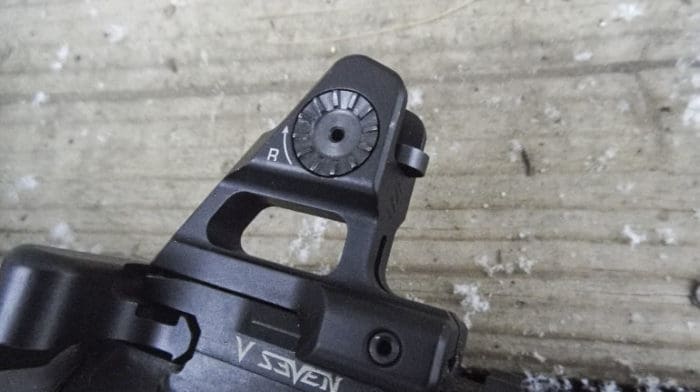
The idea of a zero at a fixed distance is a myth. All that iron sights do is give you a reference to a specific point along a bullet’s trajectory, but it’s very flexible.
If I were to take the gun in the photos, which is a 7.5” barrel 300 Blackout rifle, and zero it at 100 yards for point of impact (bullets hit right on the tip of the front sight) I can hold center mass on anything out to about 200 yards using most supersonic 110 to 125gr ammo. Past that, I can just hold high on the target, about head level, and hit center mass again.
If I wanted to be more precise at longer ranges, I can adjust my front sight just like I would on a scope. The PEAK sights are great in that they allow toolless, repeatable adjustment.
Advantages to having iron sight include their ruggedness and ability to hold their zero even with bumped getting in and out of the stand. It’s much harder to lose zero with irons as the sights are attached in a much more integrated way than a scope.
Scopes, being more delicate, are more prone to damage. Everyone has at least one story of smacking their scope on something before a key shot. You can idiot-proof your gun to a certain degree by removing glass from the equation, especially since most hunting occurs inside 200 yards anyway. That’s well within the effective range of most good iron sights.
The zero you want for an ‘emergency’ is one that accounts for the flattest part of your round’s trajectory. This idea includes both ‘close’ and ‘far’ zeroes. Many AR shooters zero their sights at 50 yards, which is the ‘close’ zero. The bullet will rise above point of aim in the meantime and again cross that point of aim somewhere around 200 yards.
This isn’t a precise means of zeroing, but it works for a lot people for their intended use. If you do this, understand that there’s no “magic” zero. You will certainly have to test it at all ranges you plan on shooting.
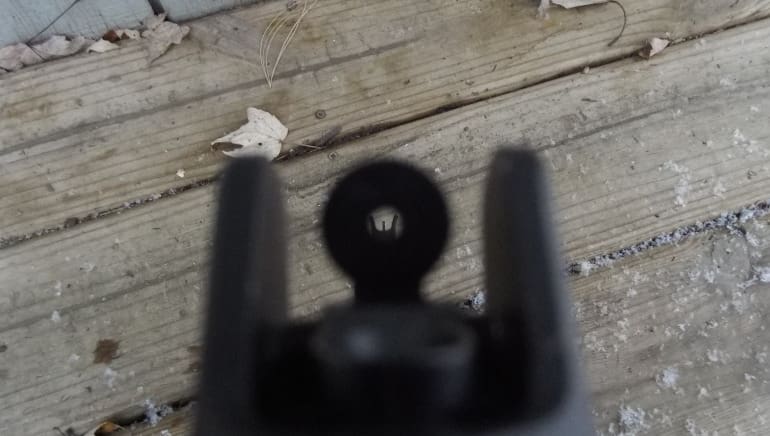
An easy way to zero is to do it at 100 yards, as most iron sight usage will take place inside that distance. Many shooters find it hard to see or aim at longer ranges, but it just takes some time to learn and you’ll be able to adjust your sights as you gain skill and learn how to best apply them.
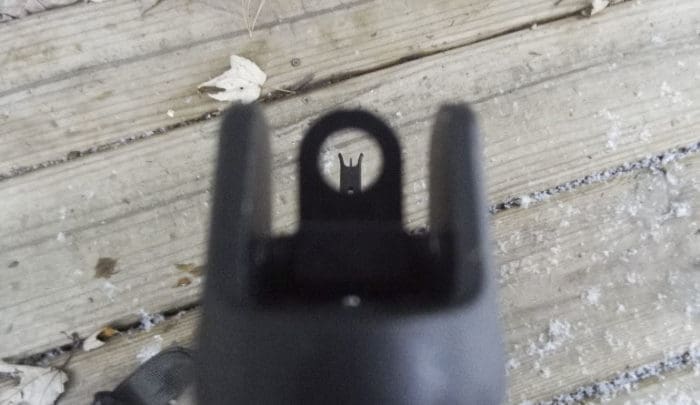
The last part I’ll address here is the size of the physical sights. Most front sights I see out there are far too thick. A wide front post won’t allow for precision shooting. That’s made worse by sloppy rear sights that have apertures with random dimensions.
The PEAK sights I recommend have a fine front post and a flip-style rear sight with both fine and wide same-plane apertures. Your elevation setting won’t change by switching between apertures, unlike many other sights out there. I like the wide one for close work and the fine one for precision shooting at longer ranges.
Give shooting with iron sights a chance. If you haven’t tried them before, you may be pleasantly surprised by their affordability, their accuracy, and their durability.
Although it takes a little getting used to, if you try out various styles and techniques, you’ll find a zeroing style that works for you. Once you practice a little, you’ll be very accurate at a surprising range of distances. You may even find yourself converting others at the range and sharing your success story with the skeptics.

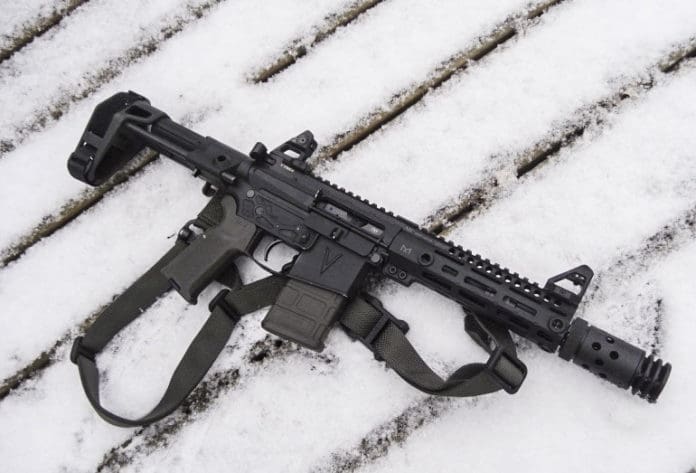



I see the AR types as SHTF weapons. Simple is good. No batteries. No glass. Rock solid rifle with no add on.
I need to get another Lee Enfield No. 4. Perfect SHTF gun.
You get what you pay for. Spend your money on the cheapest flimsiest crap and that’s what your going to end up with.
With that said, You don’t have to spend a fortune to have something worth having. With cars, computers, or even guns. Too many people think they have to buy a $3,000 AR and if they can’t then they should not get an AR. Which is complete nonsense. You might be perfectly fine with Magpul MBUS flipups. If your going to be competition shooting with an AR15 then an upgrade really should be considered though. If your going to use this thing in actual battle and not just an occasional trip to the range then spending the extra cash on higher quality becomes much more important. Even though you can’t properly develop and hone your skills with tools from the dollar store. But not all AR’s are there for that purpose.
There is nothing wrong with a Honda Civic. If you can get the job done with that then fine. Just understand that it isn’t going to be very useful when moving a house full of furniture.
CQB favors the lazurbleem ,probably. And home/neighborhood self-defense will probably be CQB, within 50 yards, thus recommending the lazurbleem again. Zombies cometh…
Those Scalarworks sights are works of art. But they’re $130 a piece, not for the set. Doing the math in my head that’d mean a set would cost $260.
~$250 + shipping on gunbroker. I’ve used Magpul BUISs on most of my girls & they seemed to work fine with older eyes. Might be time to drop coin on something better.
Good article. The fundamentals need to be touched on now and again. Though they’re not really tied to the AR. I don’t know how someone could consider themselves a rifleman and not know how to use peep sights. I think U.S. service rifles have had some of the best sights ever fielded. If you can’t shoot an M-1 or an M-1A/14 you can’t shoot a rifle.
Yeah I know iron sights are good but for whatever reason I can’t focus on them after cataract surgery. Everything else works great except that. Including driving at 80mph on the tollway! I have 2 scopes,a red dot & a 3x magnifier. The LPVO works without a battery if it goes out but no red or green illumination.
Project Appleseed teaches basic marksmanship (and America’s Founding History) very well.
I was humbled by old eyeballs and open sights using a Ruger 10/22 at 25 meters.
Like Inspector Harry Callahan, I know that, “a man has got to know his limitations.”
My close friend of 48 years died at home on 10/04/23 I found his body. That’s always an interesting endeavor. He left me all his firearms, including that 1960 Winchester 30/30 I’ve spoken about. Also in the mix was his AR9 pistol and AR15 Rifle. Both were equipped with cheap popup irons as back ups….I guess. It made no sense since the red dots needed a tool to remove them which you have to do to use the popup irons, so I didn’t see a point in them. I took them off and threw them in my AR junk drawer of various odds and ends. I can’t see good enough for iron sights anyway. Red dots and lasers for us old farts.
Time stands still for no one.
I’m sorry for your loss.
Scopes definitely have a purpose and a dot is nice and fast to aquire but both are fragile. Even the big name very expensive ones.
Nothing beats a good set of irons, that means metal. Plastic is for cheap bb guns. Even decent pellet rifles have metal sights(mostly)
Get a good set and pick a method of sighting them in that you understand. You’ll thank yourself later.
Aimpoints are probably more durable than most iron sights
Project Appleseed teaches basic marksmanship (and America’s Founding History) very well.
I was humbled by old eyeballs and open sights using a Ruger 10/22 at 25 meters.
Like Inspector Harry Callahan, I know that, “a man has got to know his limitations.”
Hamas Senior Officials Explain Why They Keep Gazan Civilians in Danger.
Hamas is on the same mission Adolf Hitler was on. They are not after terrorism. They want the extermination of all Jews. When they are done with Israel they will turn their attentions on the US.
{Hamas}
“When they are done with Israel they will turn their attentions on the US.”
That will require someone gifting them a chunk (or chunks) of fissile metal and the nuclear engineering know-how to get the desired results they want.
One or even a handful of those ‘gadgets’ won’t take down the USA…
After seeing the cowardly nature of all those that comprise the Biden Administration, are you really sure it would require all that?
My Carbines use various forge marked A2 Carry Handles each modified with a tower guide pin, relocated elevation wheel bearing-spring access and a Trijicon flip sight. The A2 style front sights are imports modified for Trijicon night sight posts, rail clamps modified not to shoot loose. My AR-308 rear sights are Ncstar A2 style shorties modified with tower guide pins, USGI windage screws, night sights, etc.
These are decent inexpensive iron sights with a nifty rail recoil lug…
https://www.at3tactical.com/products/utg-super-slim-fixed-iron-sight-set-front-and-rear
the colt le6920 sights are good
Good article.
My SHTF P308 SPR is fitted with Diamondhead Micro-D BUIS. The optic on a SPUHR QD mount.
Damage the optic? Just flip two levers and it’s off.
Two quick comments:
I decide what trajectory I want and then use a ballistic calculator to tell me where the bullet should hit at 50 yards–and proceed to zero-in at 50 yards. I choose 50 yards because that is far enough way to reveal small aiming errors, and yet close enough that wind-drift is pretty much non-existent unless it is very windy.
While I definitely value iron sights, I have opted for a low-power variable optic (LPVO) scope on my AR-15 rifle for four reasons. First, it does not rely on batteries. Second, for close quarters engagements I can set it to 1x magnification and keep both eyes open–even while aiming and shooting.* Third, for longer shots I can increase the magnification for greater accuracy and/or target identification and discrimination. Fourth, the scope collects more light than your naked eye and enables better target identification and discrimination in very low light conditions.
* When your optic is at 1x and both of your eyes are open, your “off” eye sees normally of course and your “aiming” eye sees basically the same as your “off” eye except that there are crosshairs superimposed on the imagery in your brain. It makes aiming incredibly fast/easy and vastly improves your field of vision since your “off” eye is wide open the entire time (unlike magnified scopes where you pretty much have to close your “off” eye while aiming/shooting).
Best comment on here! My AR aiming has been derailed by ILLANNOY Dimscum© I was getting the hang of my LPVO when my AR was verboten. I keep tinkering but nothing takes the place of shooting.
I agree. LPVO is an awesome choice.
I keep a Trijicon Accupower 1-8×28 LPVO on my P308. The scope ring disappears when shooting both eyes open on 1X power. Just a floating “donut of death” is visible.
My 2nd optic for this P308 is a Leupold 3.7-18×44 Mark 5 HD, also in a SPUHR QD. Should the need arise to reach out beyond the availability of the LPVO.
Follow-up:
Regarding my approach of using a ballistic calculator to tell me where my bullet should hit at 50 yards, ballistic calculators are not perfect and you could even plug erroneous information into your ballistic calculator. After I sight-in at 50 yards, I then verify that my bullet hits exactly where it should at whatever range I want it to be “zeroed”.
For example:
Suppose that I want to be “zeroed” at 300 yards and my ballistic calculator tells me that my bullets should hit 0.5 inches low at 50 yards. (The bullets may hit low at 50 yards as they are rising on their trajectory to arc above my sight-line and then fall back into my sight-line at 300 yards.) Thus I would sight-in until my bullet groups are 0.5 inches low at 50 yards and then test fire at 300 yards to ensure that my bullet groups are hitting exactly where I am aiming at 300 yards.
Note, as I mentioned above, the value of sighting-in at 50 yards to eliminate false aiming errors due to wind drift. For example consider a .223 Remington 62-grain bullet with a muzzle velocity of 3000 feet-per-second and a G1 ballistic coefficient of 0.274, shooting at 900 feet above sea level at 55 degrees F. A mild 5 mph cross breeze should cause a 0.1 inch left/right error in the point of impact at 50 yards, whereas that same 5 mph cross breeze should cause a 5.4 inch left/right error in the point of impact at 300 yards. If you sighted-in for that group at 300 yards with that 5 mph cross-breeze, now your point of aim at 300 yards is off (left/right) by 5.4 inches when there is no cross breeze–and off by 10.8 inches (left/right) if there is a cross-breeze in the opposite direction.
Continuing with the previous example (sighting-in with a 5 mph cross-breeze) at 50 yards with that left/right error of 0.1 inches rather than sighting-in at 300 yards with a resultant 5.4 inch left/right error, that 0.1 inch sighting error at 50 yards would amplify to a 0.6-inch left/right error at 300 yards which is of course negligible.
Moral of the story: unless there is no wind when you are sighting-in, sight-in at 50 yards to significantly minimize sighting errors due to cross breezes and then verify your point-of-impact for high/low aiming errors at your “zero” distance. (Note that you should be able to ignore any left/right errors at your “zero” distance which are likely due to wind drift.)
Laser snap caps can help to a point but yeah need actual shooting to get the feel of what point blank and extended shooting means for your rifle.
Used to be all rifles came with iron sights. More corner cutting and we the consumer do not see the savings.
Wood stocks, 24 inch barrel, iron sights, rubber butt pad, $800
Plastic stock, 14 inch barrel, plastic butt pad, no sights, $800.
Whaaaaaaa,,, give me back the days of a BDL
“the Scalarworks PEAK sights, are $130 for the set.”
No, they aren’t.
They are, at your article link, $129.00 each which is $258.00 for a set (front and rear).
At the Scalarworks web site they are the same price, $129.00 each which is $258.00 for a set (front and rear).
You know, i like iron sights alot. Of course i went all tacti cool with almost all my guns, but the long gun i reach for any time i really think i may need it (think mostly peaceful riots) is my good ol basic AR with a carry handle, 16” bbl and iron sights. Just feels so light and good in my hands and shoulder.
Most AR-15s have too short a sight radius for me to be able to see the front sight AND the target at the same time. If I wear my reading glasses I can see the sight, but everything past that is a blur, without the glasses everything inside of 3 feet is a blur. In general, that means iron sights are worthless to me. I do actually have a nice setup with a KAC rear sight and HK style Troy front sight on one carbine and I have also shot an M1A with irons. It is a task for me…in general I have to stick to optics of some sort. Thankfully with most of my guns I can put 5 shots inside of 1.5 inches at 100 yards with most of my guns even with a 4x scope. I wish I had learned how to use irons correctly before my eyes got bad, but I came late to the game…
As an old fart who still shoots wood and steel rifles with iron sights at a thousand yards, this amuses me.
Comments are closed.